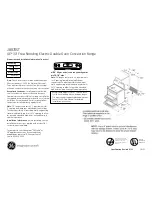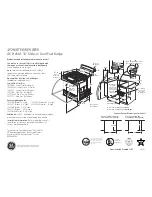
23
OPERATING THE SELF-CLEANING OVEN
(right oven—model JCP67)
Before a Clean Cycle
The range must be completely cool in order to set
the self-clean cycle.
1.
Remove the broiler pan, broiler grid, all cookware
and any aluminum foil from the oven—they can’t
withstand the high cleaning temperatures.
NOTE: The oven shelves may be cleaned in
the self-cleaning oven.
However, they will darken,
lose their luster and become hard to slide. Wipe the
shelf supports with cooking oil after self-cleaning
to make shelves slide more easily.
2.
Wipe up heavy soil on the oven bottom. If you
use soap, rinse thoroughly before self-cleaning
to prevent staining.
NOTE:
Do not clean the bake element or broil
element. Any soil will burn off when the elements
are heated. The bake element can be lifted gently
to clean the oven floor. If spillovers, residue or ash
accumulate around the bake element, gently wipe
around the element with warm water.
3.
Clean spatters or soil on the oven front frame and
the oven door outside the gasket with a dampened
cloth. The oven front frame and the oven door
outside the gasket do not get cleaned by the self-
clean cycle.
On these areas, use detergent and hot water or a
soap-filled steel wool pad. Rinse well with a
vinegar and water solution. This will help prevent
a brown residue from forming when the oven is
heated. Buff these areas with a dry cloth. Do not
clean the gasket. Never use a commercial oven
cleaner in or around the self-cleaning oven.
Clean the top, sides and outside front of the oven
door with soap and water.
Do not use abrasives or
oven cleaners.
Make sure the oven light bulb cover is in place.
Do not rub or clean the door gasket—
the fiberglass material of the gasket has an
extremely low resistance to abrasion. An intact
and well-fitting oven door gasket is essential for
energy-efficient oven operation and good baking
results. If you notice the gasket becoming worn,
frayed or damaged in any way or if it has become
displaced on the door, you should have it replaced.
Do not let water run down through openings in
the top of the door. To help prevent water from
getting in these slots when cleaning, open the door
as far as it will go.
4.
Close the oven door and make sure the oven
light is off. If the oven light is not turned off,
the life of the bulb will be shortened or it may
burn out immediately.
Do not use commercial oven cleaners or oven
protectors in or near the self-cleaning oven.
A combination of any of these products plus the
high clean-cycle temperature may damage the
porcelain finish of the oven.
IMPORTANT:
The health of some birds is
extremely sensitive to the fumes given off during the
self-cleaning cycle of any range. Move birds to
another well ventilated room.
After a Clean Cycle
You may notice some white ash in the oven. Just
wipe it up with a damp cloth after the oven cools.
If white spots remain, remove them with a soap-filled
steel wool pad. Be sure to rinse thoroughly with a
vinegar and water mixture. These deposits are usually
a salt residue that cannot be removed by the clean cycle.
If the oven is not clean after one clean cycle, repeat
the cycle.
If the shelves become hard to slide, apply a small
amount of vegetable oil or cooking oil to a paper
towel and wipe the edges of the oven shelves with
the paper towel.
NOTE:
No functions can be programmed before the
door automatically unlocks.
(continued next page)
Oven light
Oven front frame
Oven door gasket
Openings in door
Br
oiling Guide
Operating the Self-Cleaning Oven
ge.com
Summary of Contents for JCP67
Page 39: ...38 NOTES ...
















































